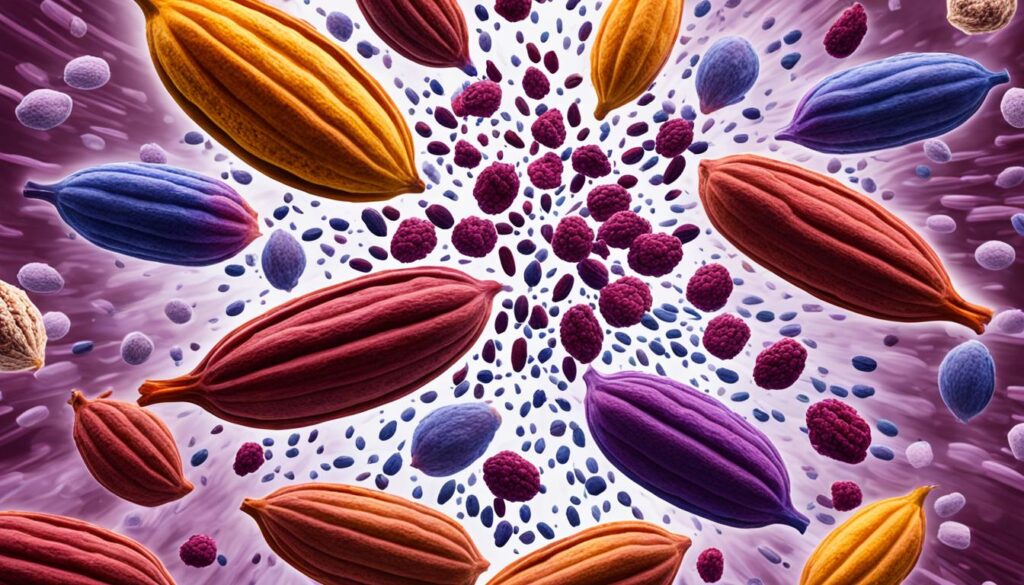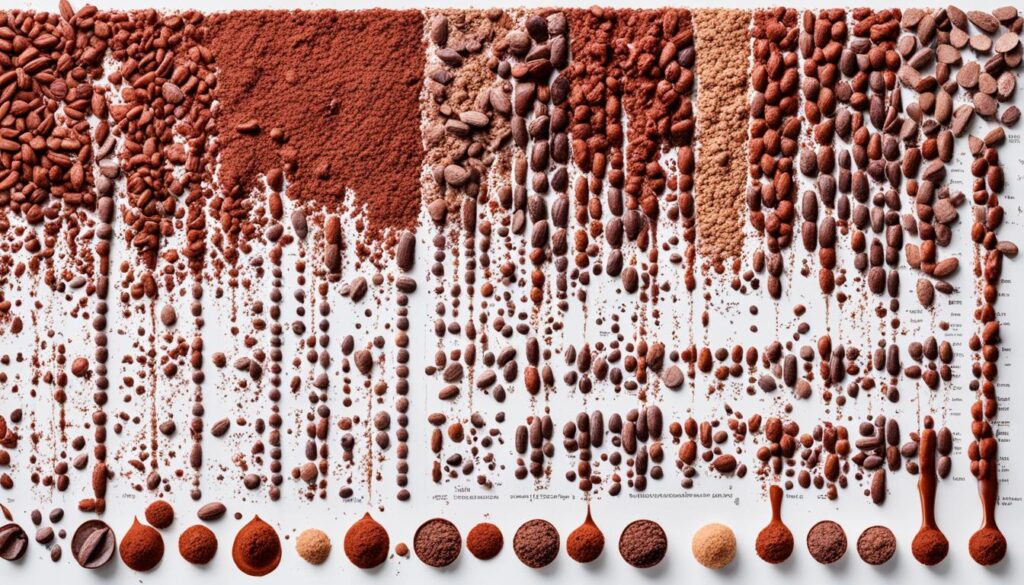Cocoa, derived from the cacao plant, is a widely consumed ingredient in various food and beverage products. However, the impact of cocoa consumption on allergic reactions is a topic of interest, as some individuals may experience adverse reactions to cocoa or chocolate. This comprehensive article will explore the relationship between cocoa consumption and its potential to trigger or alleviate allergic reactions.
Key Takeaways
- Cocoa contains a variety of compounds that can trigger allergic reactions in some individuals.
- The antioxidant and anti-inflammatory properties of cocoa may help alleviate certain types of allergies.
- Common allergens in cocoa products include milk, tree nuts, and soy.
- Cocoa’s impact on respiratory and skin allergies is an area of ongoing research.
- Individuals with known cocoa or food allergies must exercise caution and read labels carefully.
Introduction to Cocoa and Allergic Reactions
Cocoa, the key ingredient in chocolate, is obtained from the seeds of the cacao tree. This versatile substance contains a variety of compounds, including proteins, fats, and antioxidants, which can potentially trigger allergic reactions in some individuals. Understanding the what is cocoa and the cocoa overview is crucial to comprehending the complex relationship between cocoa consumption and allergic reactions.
What is Cocoa?
Cocoa is a natural product derived from the cacao plant, known for its rich, distinctive flavor and wide use in the confectionery industry. The cocoa overview reveals that this substance is a complex mixture of various compounds, including proteins, fats, and a range of antioxidants, which contribute to its unique characteristics and potential impact on human health.
Prevalence of Allergic Reactions
The prevalence of allergic reactions to cocoa or chocolate-based products can vary, with estimates suggesting that around 1-2% of the population may have a cocoa or chocolate allergy. These allergy statistics highlight the importance of understanding the potential for cocoa to trigger adverse reactions, particularly among individuals with common allergies such as milk, tree nut, and soy allergies.
By exploring the what is cocoa, cocoa overview, and the prevalence of allergic reactions, we can better understand the complex interplay between this ubiquitous ingredient and the potential for allergic responses.
Cocoa and the Immune System

Cocoa, a rich source of antioxidants, plays a significant role in influencing the immune system. The antioxidants in cocoa, particularly the flavonoids, possess remarkable properties that can modulate the body’s immune response. These antioxidants have been linked to both anti-inflammatory and anti-allergic effects, which can potentially alleviate certain types of allergic reactions.
Antioxidants in Cocoa
Cocoa is renowned for its high concentration of antioxidants, including polyphenols and flavonoids. These powerful compounds have been extensively studied for their potential health benefits, including their ability to support the immune system. The antioxidants in cocoa can help neutralize harmful free radicals, reducing inflammation and potentially mitigating the body’s allergic responses.
Anti-Inflammatory Properties
The anti-inflammatory properties of cocoa have been the subject of ongoing research. Studies suggest that the antioxidants in cocoa can help modulate the inflammatory response, which is a key component of many allergic reactions. By reducing inflammation, cocoa may contribute to the alleviation of certain types of allergies, such as those associated with respiratory or skin conditions.
The interplay between cocoa and the immune system is a complex and intriguing area of study. As researchers continue to explore the nuances of this relationship, new insights may emerge to guide individuals and healthcare professionals in better understanding the potential benefits and limitations of cocoa consumption in the context of allergic reactions.
How does cocoa consumption impact allergic reactions?

The impact of cocoa consumption on allergic reactions can be complex and multifaceted. Cocoa can potentially trigger allergic responses in individuals with specific allergies, such as milk, tree nut, or soy allergies. However, the antioxidant and anti-inflammatory properties of cocoa may also play a role in modulating the immune system and potentially alleviating certain types of allergic reactions. The specific impact of cocoa consumption on an individual’s allergic reactions can vary based on factors such as the individual’s sensitivity, the form of cocoa consumed, and the presence of other allergens.
For instance, individuals with milk or dairy allergies may experience adverse reactions when consuming cocoa-based products that contain milk or dairy ingredients. Similarly, those with tree nut allergies may need to be cautious of cocoa products that contain nuts, such as almonds or hazelnuts. Additionally, the presence of soy in some cocoa-containing items can trigger allergic responses in individuals with soy allergies.
On the other hand, the anti-inflammatory properties of cocoa may have a beneficial effect on certain types of allergic reactions, such as those associated with respiratory or skin conditions. Some studies suggest that the antioxidants in cocoa can help modulate the immune system and potentially alleviate symptoms in individuals with allergies.
Ultimately, the impact of cocoa consumption on allergic reactions can be highly individualized, and it is important for each person to be aware of their own sensitivity and any specific allergies they may have. Consulting with healthcare professionals and carefully monitoring reactions to cocoa-containing products can help individuals manage their allergies and find a balanced approach to cocoa consumption.
Common Allergens in Cocoa Products

Cocoa-based products, such as chocolate, can contain various allergens that may trigger allergic reactions in some individuals. The most common allergens found in cocoa products include milk and dairy, tree nuts, and soy. Individuals with these specific allergies must exercise caution when consuming cocoa-containing items, as the presence of these allergens can lead to adverse reactions.
Milk and Dairy
Milk and dairy products are among the most prevalent allergens in cocoa-based foods. Individuals with a milk or dairy allergy may experience symptoms like hives, digestive issues, or even anaphylaxis when consuming cocoa products that contain these ingredients. Careful label reading and avoidance of milk-containing cocoa items are essential for those with milk and dairy allergies.
Tree Nuts
Tree nuts, such as almonds, hazelnuts, and peanuts, are another common allergen found in cocoa-containing products. For individuals with tree nut allergies, the presence of these allergens in chocolate or other cocoa-based items can trigger severe reactions, including swelling, respiratory distress, and even life-threatening anaphylaxis. Individuals with tree nut allergies must be vigilant in scanning ingredient lists for any tree nut-derived components.
Soy
Soy is also a prevalent allergen that may be present in cocoa products, particularly in the form of soy lecithin, a common emulsifier used in chocolate production. Individuals with soy allergies may experience symptoms like digestive discomfort, skin irritation, or even respiratory issues when consuming cocoa items containing soy-derived ingredients. Careful examination of product labels is essential for those with soy allergies.
| Allergen | Potential Symptoms | Precautions |
|---|---|---|
| Milk and Dairy | Hives, digestive issues, anaphylaxis | Avoid milk-containing cocoa products |
| Tree Nuts | Swelling, respiratory distress, anaphylaxis | Check for tree nut ingredients |
| Soy | Digestive discomfort, skin irritation, respiratory issues | Avoid soy-derived ingredients in cocoa products |
Cocoa and Respiratory Allergies

The connection between cocoa consumption and respiratory allergies, such as asthma, is an area of ongoing scientific exploration. Emerging research suggests that the antioxidant and anti-inflammatory properties of cocoa may have a beneficial impact on respiratory function and potentially alleviate asthma symptoms.
Asthma and Cocoa
Several studies have investigated the relationship between cocoa and its effects on asthma. The antioxidants found in cocoa, including flavonoids, have been shown to possess anti-inflammatory properties that may help reduce airway inflammation and improve respiratory function in individuals with asthma. This potential benefit of cocoa consumption could be particularly relevant for those dealing with respiratory allergies and asthma.
However, it is important to note that individuals with existing respiratory allergies should still exercise caution when consuming cocoa-based products. The presence of other potential allergens, such as milk, tree nuts, or soy, in some cocoa-containing items could still trigger adverse reactions in those with sensitivities. Careful label reading and a personalized approach are essential for managing cocoa consumption and respiratory allergies.
Cocoa and Skin Allergies

Cocoa consumption has also been studied in relation to skin allergies, such as eczema and contact dermatitis. Some research indicates that the anti-inflammatory properties of cocoa may help alleviate symptoms of eczema, a chronic skin condition. However, for individuals with existing skin allergies, the direct contact with cocoa-containing products or the presence of other allergens in these products may trigger adverse skin reactions, such as contact dermatitis.
Eczema and Cocoa
Cocoa’s anti-inflammatory properties have been explored for their potential to aid in the management of eczema. Studies suggest that the antioxidants and other beneficial compounds found in cocoa may help soothe the symptoms associated with this chronic skin condition, which is often characterized by inflammation and irritation.
Contact Dermatitis
While cocoa may offer potential benefits for individuals with eczema, the direct contact with cocoa-containing products can be a concern for those with preexisting skin allergies. The presence of allergens, such as milk, tree nuts, or soy, in cocoa-based products can trigger adverse skin reactions like contact dermatitis, a type of skin inflammation caused by an allergic response to a specific substance.
Cocoa and Food Allergies

Cocoa-based products can be a concern for individuals with specific food allergies, particularly peanut, tree nut, and milk/dairy allergies. The presence of these allergens in chocolate and other cocoa-containing foods can trigger an immune system response, leading to potentially severe allergic reactions. Individuals with these food allergies must exercise caution when consuming cocoa-based products and carefully read labels to ensure the absence of their specific allergens.
Peanut and Tree Nut Allergies
Peanuts and tree nuts, such as almonds, hazelnuts, and walnuts, are common ingredients in many cocoa-containing products, including chocolate bars, spreads, and baked goods. For individuals with peanut or tree nut allergies, the consumption of these cocoa-based items can result in adverse reactions, including anaphylaxis, a potentially life-threatening condition. Strict avoidance of cocoa products that may contain these allergens is crucial for those with peanut or tree nut allergies.
Milk and Dairy Allergies
Milk and dairy products are also frequently used in the production of cocoa-based foods and beverages, such as chocolate milk, hot chocolate, and various confections. Individuals with milk or dairy allergies must be particularly vigilant when consuming cocoa-containing items, as the presence of these allergens can trigger unpleasant and potentially dangerous reactions. Reading labels and being aware of the potential for cross-contamination during manufacturing are essential steps for managing milk and dairy allergies in relation to cocoa consumption.
Precautions for Cocoa Consumption

For individuals with known cocoa or chocolate allergies, or those with other food allergies that may be triggered by cocoa products, it is essential to take precautions when consuming cocoa-containing items. This includes carefully reading labels to identify the presence of allergens, such as milk, tree nuts, or soy, and being aware of the potential for cross-contamination during the manufacturing or preparation process. Maintaining vigilance and following appropriate allergy management strategies can help mitigate the risks associated with cocoa consumption.
Reading Labels
When it comes to precautions for cocoa consumption, reading labels is of paramount importance. Individuals with cocoa allergies or other food allergies should thoroughly inspect the ingredient list of any cocoa-based products they intend to consume. This includes being on the lookout for common allergens like milk, tree nuts, and soy, which may be present in the formulation. By carefully reading labels, consumers can make informed decisions and avoid potential allergic reactions.
Cross-Contamination Risks
In addition to reading labels, it is crucial to be aware of the cross-contamination risks associated with cocoa consumption. Cocoa-containing products may be produced in facilities that also handle other allergens, leading to the potential for cross-contamination. Individuals with cocoa allergies should be mindful of this and take appropriate precautions, such as avoiding certain brands or products or contacting manufacturers to inquire about their allergy management processes. Preventing cross-contamination is a vital step in cocoa allergy prevention.
Moderation and Individualized Approach
When it comes to the impact of cocoa consumption on allergic reactions, a balanced and individualized approach is recommended. While some individuals may be able to tolerate cocoa consumption without any adverse effects, others may need to limit or avoid cocoa-containing products. It is essential for individuals to be aware of their own sensitivity and any specific allergies they may have, and to consult with healthcare professionals to develop a personalized plan for managing their cocoa consumption and potential allergic reactions.
The worldwide average chocolate consumption is estimated to be 0.9 kg per capita per year, according to recent data. However, for those with cocoa allergies or sensitivities, moderation in cocoa consumption and an individualized approach to managing allergies is crucial. By working closely with healthcare professionals, individuals can develop a personalized strategy to manage their cocoa allergies and cocoa consumption in a way that balances their health and lifestyle needs.
| Key Considerations for Managing Cocoa Allergies | Recommendations |
|---|---|
| Reading Labels | Carefully examine ingredient lists to identify the presence of potential allergens, such as milk, tree nuts, or soy, in cocoa-containing products. |
| Cross-Contamination Risks | Be aware of the potential for cross-contamination during manufacturing or preparation of cocoa-based foods and beverages. |
| Individualized Approach | Consult with healthcare professionals to develop a personalized plan for managing cocoa allergies and determining the appropriate level of cocoa consumption. |
By adopting a moderation in cocoa consumption and an individualized approach to cocoa allergies, individuals can find a balanced way to enjoy the potential benefits of cocoa while effectively managing their cocoa-related allergies. This approach, combined with ongoing research and healthcare guidance, can help individuals navigate the complex relationship between cocoa consumption and allergies.
Research and Future Directions
The relationship between cocoa consumption and allergic reactions is an area of ongoing research and investigation. While some studies have explored the potential benefits of cocoa’s antioxidant and anti-inflammatory properties in modulating the immune system and alleviating certain types of allergies, more research is needed to fully understand the complex interactions between cocoa and the human body’s allergic responses. As future research on cocoa and allergic reactions continues, new insights may emerge that can help guide individuals and healthcare professionals in managing cocoa-related allergies more effectively.
Researchers are actively investigating the mechanisms by which cocoa may influence the body’s immune response and its potential to either trigger or alleviate allergic reactions. By delving deeper into the research on cocoa and allergies, scientists hope to uncover novel strategies for managing cocoa-related allergic reactions and provide more personalized guidance for individuals with cocoa sensitivities.
As the emerging insights on cocoa and allergies continue to unfold, healthcare professionals and the public can stay informed and proactive in addressing the complexities of this relationship. By collaborating with researchers and staying up-to-date on the latest findings, individuals can make more informed decisions about their cocoa consumption and develop effective management plans for any allergic reactions they may experience.
| Ongoing Research Areas | Future Directions |
|---|---|
|
|
“As research on the interplay between cocoa and allergic reactions continues, we are poised to uncover new and more effective ways to help individuals navigate the complex relationship between their cocoa consumption and their unique allergic responses.”
Conclusion
In conclusion, the impact of cocoa consumption on allergic reactions is a complex and multifaceted topic. While cocoa may possess beneficial properties that can potentially alleviate certain types of allergic responses, it can also trigger adverse reactions in individuals with specific allergies, such as milk, tree nut, or soy allergies. The conclusion on cocoa and allergic reactions is that a personalized and cautious approach is necessary when managing cocoa consumption and any associated allergic reactions.
The key takeaways on cocoa and allergies are that individuals must stay informed, read labels carefully, and work closely with healthcare professionals to navigate the relationship between cocoa and their own unique allergic responses. By understanding the summary of impact of cocoa on allergies, individuals can make informed decisions and take appropriate precautions to manage their cocoa consumption and potential allergic reactions effectively.
Ultimately, the impact of cocoa consumption on allergic reactions is a complex and nuanced topic that requires a tailored approach for each individual. By remaining vigilant, seeking professional guidance, and being mindful of potential allergens, individuals can find a balance that allows them to enjoy the benefits of cocoa while mitigating the risks associated with their unique allergic profile.

Leave a Reply